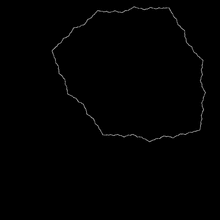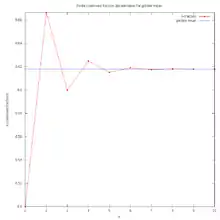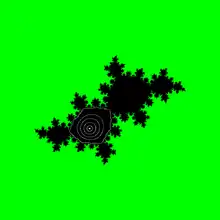Difference between sequences and series
types of sequences
Integer sequences
Fraction sequences
Farey sequence

The Farey sequence of order n is the sequence of completely reduced vulgar fractions between 0 and 1 which when in lowest terms have denominators less than or equal to n, arranged in order of increasing size.
Each Farey sequence starts with the value 0, denoted by the fraction 0⁄1, and ends with the value 1, denoted by the fraction 1⁄1 (although some authors omit these terms).
Farey Addition = the mediant of two fractions :
Terms
- next term = child
- Previous terms = parents[1]
Farey tree = Farey sequence as a tree
| Sorted |
|---|
F1 = {0/1, 1/1}
F2 = {0/1, 1/2, 1/1}
F3 = {0/1, 1/3, 1/2, 2/3, 1/1}
F4 = {0/1, 1/4, 1/3, 1/2, 2/3, 3/4, 1/1}
F5 = {0/1, 1/5, 1/4, 1/3, 2/5, 1/2, 3/5, 2/3, 3/4, 4/5, 1/1}
F6 = {0/1, 1/6, 1/5, 1/4, 1/3, 2/5, 1/2, 3/5, 2/3, 3/4, 4/5, 5/6, 1/1}
F7 = {0/1, 1/7, 1/6, 1/5, 1/4, 2/7, 1/3, 2/5, 3/7, 1/2, 4/7, 3/5, 2/3, 5/7, 3/4, 4/5, 5/6, 6/7, 1/1}
F8 = {0/1, 1/8, 1/7, 1/6, 1/5, 1/4, 2/7, 1/3, 3/8, 2/5, 3/7, 1/2, 4/7, 3/5, 5/8, 2/3, 5/7, 3/4, 4/5, 5/6, 6/7, 7/8, 1/1}
|
Sequences on the parameter plane
Sequences of Misiurewicz points
- external ray for angle 1/(4*2^n) land on the tip of the first brach: 1/4, 1/8, 1/16, 1/32, 1/64, ...
- 1/(6*2^n) - land on the second branch
- principal Misiurewicz point of wake p/q
Period doubling scenario
Sharkovsky ordering
It is the infinite sequence of positive integers. It starts from 3 and ends in 1. It contains infinitely many subsequences.
"The Sharkovski ordering :
- begins with the odd numbers >= 3,
- then twice these numbers,
- then 4 times them,
- then 8 times them,
- etc.,
- ending with the powers of 2 in decreasing order, ending with 2^0 = 1."[2]
sequence of fraction in the elephant valley
In the elephant valley[3][4] ( from parameter plane ) there is a sequence of componts with period p : from 1/2 to 1/p
Note that :
- internal ray 0/1 = 1/1
- internal angle 1/p means that ray goes from period 1 component ( parent period = 1) to period p component ( child period = p)
- as child period grows computations are harder
- exponential growth[5] of . One can easly create a numeric value that is too large to be represented within the available storage space ( integer overflow[6] ). For example is to big for short ( 16 bit ) and long ( 32 bit) integer.
The upper principal sequence of rotational number around the main cardioid of Mandelbrot set[7]
| n | rotation number = 1/n | parameter c |
|---|---|---|
| 2 | 1/2 | -0.75 |
| 3 | 1/3 | 0.64951905283833*i-0.125 |
| 4 | 1/4 | 0.5*i+0.25 |
| 5 | 1/5 | 0.32858194507446*i+0.35676274578121 |
| 6 | 1/6 | 0.21650635094611*i+0.375 |
| 7 | 1/7 | 0.14718376318856*i+0.36737513441845 |
| 8 | 1/8 | 0.10355339059327*i+0.35355339059327 |
| 9 | 1/9 | 0.075191866590218*i+0.33961017714276 |
| 10 | 1/10 | 0.056128497072448*i+0.32725424859374 |
See :
- Slide show of rescaled limbs converging to the Lavaurs elephant - video by Wolf Jung made with Mandel
sequence of parabolic points on the boundary of main cardioid
Here:
- t = internal angle ( or rotation number) of main cardioid
- q = number of the critical orbit (star) arms. It means that one have to do q iterations around fixed point to move one point toward fixed point along arm.
- c is a root point between hyperbolic components of period 1 ( = main cardioid) and period q. This point is at the end ( radius = 1) of internal ray for angle t
| k = log10(q) | (double) t | ||
|---|---|---|---|
| 1 | 3/10 | 0.3 | +0.047745751406263+0.622474571220695 i |
| 2 | 33/100 | 0.33 | -0.106920138306109 +0.649235321397436 i |
| 3 | 333/1000 | 0.333 | -0.123186752260805 +0.649516204880454 i |
| 4 | 3333/10000 | 0.3333 | -0.124818625550005 +0.649519024348384 i |
| 5 | 33333/100000 | 0.33333 | -0.124981862061192 +0.649519052553419 i |
| 6 | 333333/1000000 | 0.333333 | -0.124998186201184 +0.649519052835480 i |
| 7 | 3333333/10000000 | 0.3333333 | -0.124999818620069 +0.649519052838300 i |
| 8 | 33333333/100000000 | 0.33333333 | -0.124999981862006 +0.649519052838329 i |
| 9 | 333333333/1000000000 | 0.333333333 | -0.124999998186201 +0.649519052838329 i |
| 10 | 3333333333/10000000000 | 0.3333333333 | -0.124999999818620 +0.649519052838329 i |
sequence from Siegel disk to Leau-Fatou flower
- plain Siegel disk
- digitated Siegel disk[8]
- virtual Siegel disk
- ? Leau-Fatou flower ?

1 over 3
| n | t | ||
|---|---|---|---|
| 0 | 0.2763932022500210 | +0.1538380639536641 + 0.5745454151066985 i | |
| 1 | 0.3231874668087892 | -0.0703924965263780 + 0.6469145331346999 i | |
| 2 | 0.3322326933513446 | -0.1190170769366243 + 0.6494880316361160 i | |
| 3 | 0.3332223278292314 | -0.1243960357918422 + 0.6495187369145560 i | |
| 4 | 0.3333222232791965 | -0.1249395463818515 + 0.6495190496732967 i | |
| 5 | 0.3333322222327929 | -0.1249939540657307 + 0.6495190528066729 i | |
| 6 | 0.3333332222223279 | -0.1249993954008480 + 0.6495190528380124 i | |
| 7 | 0.3333333222222233 | -0.1249999395400276 + 0.6495190528383258 i | |
| 8 | 0.3333333322222222 | -0.1249999939540022 + 0.6495190528383290 i | |
| 9 | 0.3333333332222223 | -0.1249999993954002 + 0.6495190528383290 i | |
| 10 | 0.3333333333222222 | -0.1249999999395400 + 0.6495190528383290 i | |
| 11 | 0.3333333333322222 | -0.1249999999939540 + 0.6495190528383290 i |
sequence of fractions tending to the golden mean ( Golden Ratio Conjugate )


n = 1 ; p_n/q_n = 1.0000000000000000000 = 1 / 1 n = 2 ; p_n/q_n = 0.5000000000000000000 = 1 / 2 n = 3 ; p_n/q_n = 0.6666666666666666667 = 2 / 3 n = 4 ; p_n/q_n = 0.6000000000000000000 = 3 / 5 n = 5 ; p_n/q_n = 0.6250000000000000000 = 5 / 8 n = 6 ; p_n/q_n = 0.6153846153846153846 = 8 / 13 n = 7 ; p_n/q_n = 0.6190476190476190476 = 13 / 21 n = 8 ; p_n/q_n = 0.6176470588235294118 = 21 / 34 n = 9 ; p_n/q_n = 0.6181818181818181818 = 34 / 55 n = 10 ; p_n/q_n = 0.6179775280898876404 = 55 / 89 n = 11 ; p_n/q_n = 0.6180555555555555556 = 89 / 144 n = 12 ; p_n/q_n = 0.6180257510729613734 = 144 / 233 n = 13 ; p_n/q_n = 0.6180371352785145888 = 233 / 377 n = 14 ; p_n/q_n = 0.6180327868852459016 = 377 / 610 n = 15 ; p_n/q_n = 0.6180344478216818642 = 610 / 987 n = 16 ; p_n/q_n = 0.6180338134001252348 = 987 / 1597 n = 17 ; p_n/q_n = 0.6180340557275541796 = 1597 / 2584 n = 18 ; p_n/q_n = 0.6180339631667065295 = 2584 / 4181 n = 19 ; p_n/q_n = 0.6180339985218033999 = 4181 / 6765 n = 20 ; p_n/q_n = 0.6180339850173579390 = 6765 / 10946 n = 21 ; p_n/q_n = 0.6180339901755970865 = 10946 / 17711 n = 22 ; p_n/q_n = 0.6180339882053250515 = 17711 / 28657 n = 23 ; p_n/q_n = 0.6180339889579020014 = 28657 / 46368 n = 24 ; p_n/q_n = 0.6180339886704431856 = 46368 / 75025 n = 25 ; p_n/q_n = 0.6180339887802426829 = 75025 / 121393 n = 26 ; p_n/q_n = 0.6180339887383030068 = 121393 / 196418 n = 27 ; p_n/q_n = 0.6180339887543225376 = 196418 / 317811 n = 28 ; p_n/q_n = 0.6180339887482036214 = 317811 / 514229 n = 29 ; p_n/q_n = 0.6180339887505408394 = 514229 / 832040 n = 30 ; p_n/q_n = 0.6180339887496481015 = 832040 / 1346269 n = 31 ; p_n/q_n = 0.6180339887499890970 = 1346269 / 2178309 n = 32 ; p_n/q_n = 0.6180339887498588484 = 2178309 / 3524578 n = 33 ; p_n/q_n = 0.6180339887499085989 = 3524578 / 5702887 n = 34 ; p_n/q_n = 0.6180339887498895959 = 5702887 / 9227465 n = 35 ; p_n/q_n = 0.6180339887498968544 = 9227465 / 14930352 n = 36 ; p_n/q_n = 0.6180339887498940819 = 14930352 / 24157817 n = 37 ; p_n/q_n = 0.6180339887498951409 = 24157817 / 39088169 n = 38 ; p_n/q_n = 0.6180339887498947364 = 39088169 / 63245986 n = 39 ; p_n/q_n = 0.6180339887498948909 = 63245986 / 102334155 n = 40 ; p_n/q_n = 0.6180339887498948319 = 102334155 / 165580141 n = 41 ; p_n/q_n = 0.6180339887498948544 = 165580141 / 267914296 n = 42 ; p_n/q_n = 0.6180339887498948458 = 267914296 / 433494437 n = 43 ; p_n/q_n = 0.6180339887498948491 = 433494437 / 701408733 n = 44 ; p_n/q_n = 0.6180339887498948479 = 701408733 / 1134903170 n = 45 ; p_n/q_n = 0.6180339887498948483 = 1134903170 / 1836311903
This is a sequence of rational numbers ( Julia sets are parabolic). It's limit is an irrational number ( Julia set has a Siegel disk).
Sequence on the dynamic plane
More
- orbit
References
- ↑ Finding parents in the Farey tree by Claude Heiland-Allen
- ↑ The On-Line Encyclopedia of Integer Sequences : A005408 = The odd numbers: a(n) = 2n+1
- ↑ muency : elephant valley
- ↑ Visual Guide To Patterns In The Mandelbrot Set by Miqel
- ↑ integer number in wikipedia
- ↑ Integer overflow in wikipedia
- ↑ Mandel Set Combinatorics : Principal Series
- ↑ scholarpedia : Siegel_disks , Quadratic_Siegel_disks, Digitation